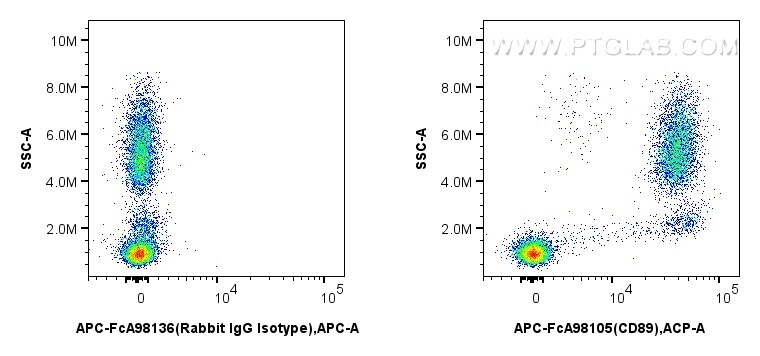Tested Applications
| Positive FC detected in | human peripheral blood leukocytes |
Recommended dilution
| Application | Dilution |
|---|---|
| This reagent has been pre-titrated and tested for flow cytometric analysis. The suggested use of this reagent is 5 ul per 10^6 cells in a 100 µl suspension or 5 ul per 100 µl of whole blood. | |
| Sample-dependent, Check data in validation data gallery. | |
Product Information
APC-FcA98105 targets CD89 in FC applications and shows reactivity with human samples.
| Tested Reactivity | human |
| Host / Isotype | Rabbit / IgG |
| Class | Recombinant |
| Type | Antibody |
| Immunogen | Recombinant Protein Predict reactive species |
| Full Name | Fc fragment of IgA, receptor for |
| Calculated Molecular Weight | 287 aa, 32 kDa |
| GenBank Accession Number | BC027953 |
| Gene Symbol | CD89 |
| Gene ID (NCBI) | 2204 |
| Conjugate | APC Fluorescent Dye |
| Excitation/Emission Maxima Wavelengths | 650 nm / 660 nm |
| Form | Liquid |
| Purification Method | Protein A purification |
| Storage Buffer | PBS with 0.09% sodium azide and 0.5% BSA , pH 7.3 |
| Storage Conditions | Store at 2-8°C. Avoid exposure to light. Stable for one year after shipment. |
Background Information
FcαRI (CD89) is a member of the Fc receptor immunoglobulin superfamily, constitutively expressed on cells of the myeloid lineage like neutrophils, eosinophils, monocytes macrophages, and platelets (PMID: 28103138). CD89 expression and activation are increased in human blood phagocytes following bacterial infection, together with increased expression and association of FcRγ with CD89 (PMID: 34756952). CD89 binds both subclasses of IgA (IgA1 and IgA2) with moderate affinity, but also binds other molecules such as TfR1, C-reactive protein and bacterial ligands. CD89 represents an effective target molecule for immunotherapy mediated by bispecific antibodies (PMID: 37081893).
Protocols
| Product Specific Protocols | |
|---|---|
| FC protocol for APC CD89 antibody APC-FcA98105 | Download protocol |
| Standard Protocols | |
|---|---|
| Click here to view our Standard Protocols |



